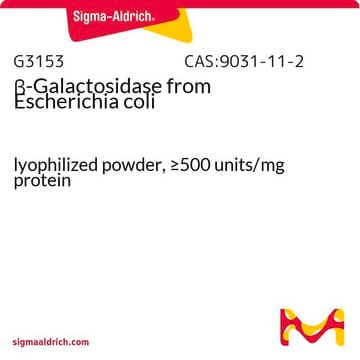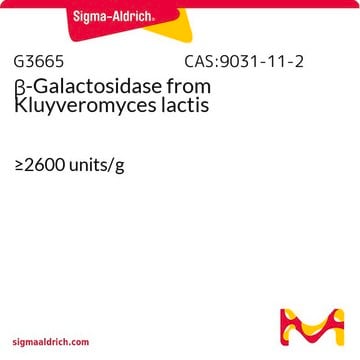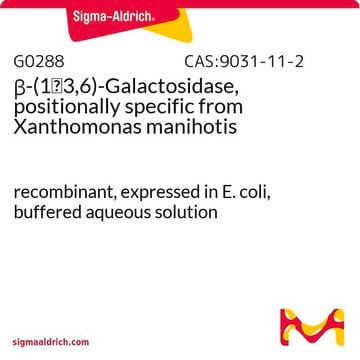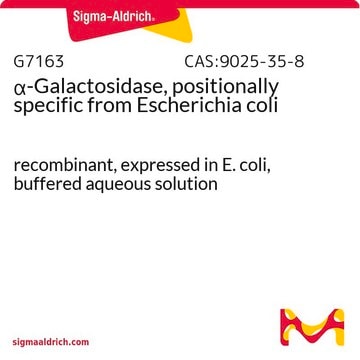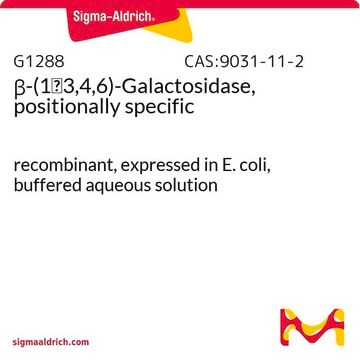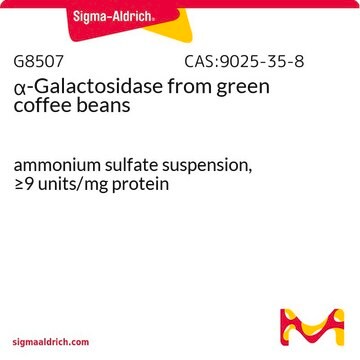G4155
β-Galactosidase from Escherichia coli
aqueous glycerol suspension, ≥500 units/mg protein (biuret)
Synonym(s):
β-D-Galactoside galactohydrolase, Lactase
Sign Into View Organizational & Contract Pricing
All Photos(1)
About This Item
CAS Number:
MDL number:
UNSPSC Code:
12352204
NACRES:
NA.54
Recommended Products
form
aqueous glycerol suspension
Quality Level
specific activity
≥500 units/mg protein (biuret)
mol wt
465 kDa
storage temp.
−20°C
Looking for similar products? Visit Product Comparison Guide
Related Categories
Application
β-Galactosidase is used in the enzymatic assays in the synthesis of imidazolo-pyrrolidinoses.
Biochem/physiol Actions
β-galactosidase cleaves lactose into its monosaccharide components, glucose and galactose. It also catalyses the transglycosylation of glucose into allolactose, the inducer of β-galactosidase, in a feedback loop.
Physical properties
Tetramer molecular weight 465 kDa (subunits 116.3 kDa each)
Unit Definition
One unit will hydrolyze 1.0 μmole of o-nitrophenyl β-D-galactoside to o-nitrophenol and D-galactose per min at pH 7.3 at 37 °C.
Physical form
Suspension in 50% glycerol, 5 mM Tris buffer salts, 5 mM magnesium chloride, 0.5 mM DTT, 0.5 mM mercaptoethanol. pH 7.4
Other Notes
Loss of enzymatic activity can occur if this enzyme is frozen. This enzyme is provided in a 50% glycerol solution and will not freeze if stored at -20° Celsius. It is not recommended that this enzyme preparation be stored in an ultracold freezer (-60 to -100° Celsius).
inhibitor
Product No.
Description
Pricing
substrate
Product No.
Description
Pricing
Storage Class Code
10 - Combustible liquids
WGK
WGK 2
Flash Point(F)
Not applicable
Flash Point(C)
Not applicable
Choose from one of the most recent versions:
Certificates of Analysis (COA)
Lot/Batch Number
Don't see the Right Version?
If you require a particular version, you can look up a specific certificate by the Lot or Batch number.
Already Own This Product?
Find documentation for the products that you have recently purchased in the Document Library.
Customers Also Viewed
Théophile Tschamber et al.
Bioorganic & medicinal chemistry, 11(17), 3559-3568 (2003-08-07)
The syntheses of four glyco-imidazoles, which are pentose-derivatives belonging to the D-series, as well as the syntheses of their L-enantiomers, are reported. Starting from the known linear xylo, lyxo, arabino, and ribo imidazolo-pentoses in both the L- and the D-series
Olga Ermakova et al.
Brain sciences, 11(6) (2021-07-03)
Acquisition of detailed anatomical and molecular knowledge from intact biological samples while preserving their native three-dimensional structure is still a challenging issue for imaging studies aiming to unravel a system's functions. Three-dimensional micro-CT X-ray imaging with a high spatial resolution
S Zhang et al.
The Biochemical journal, 348 Pt 3, 621-632 (2000-06-07)
We have identified and characterized three missense mutations in a patient with type 1 G(M1) gangliosidosis, namely a substitution of G for A at nucleotide position 1044 (G1044-->A; in exon 10) on one allele, which converts Asp(332) into asparagine, and
A Hinek et al.
American journal of human genetics, 67(1), 23-36 (2000-06-08)
We have previously shown that intracellular trafficking and extracellular assembly of tropoelastin into elastic fibers is facilitated by the 67-kD elastin-binding protein identical to an enzymatically inactive, alternatively spliced variant of beta-galactosidase (S-Gal). In the present study, we investigated elastic-fiber
J Nishimoto et al.
American journal of human genetics, 49(3), 566-574 (1991-09-01)
GM1-gangliosidosis is a genetic neurological disorder caused by mutations in the lysosomal acid beta-galactosidase gene. While its phenotypic expression is complex, it is usually classified as being of infantile, juvenile, or adult form, on the basis of age at onset
Our team of scientists has experience in all areas of research including Life Science, Material Science, Chemical Synthesis, Chromatography, Analytical and many others.
Contact Technical Service

